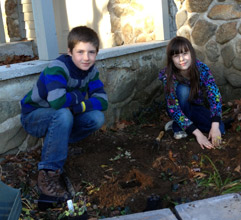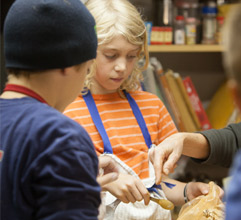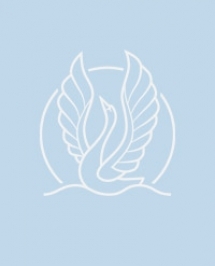Fourth Grade




Meg Pechenick
Fourth Grade Teacher
University of Vermont, BA
MIIS-Monterey, MA
In fourth grade, we jump with both feet into applying the skills acquired in the lower grades to learn more complex knowledge. Fourth graders integrate with students in other grades during STEAMS blocks, After School Enrichment, weekly Sharing Assemblies and Clubs.
We begin our days outside connecting with nature and participating in adventure-based community-building activities. Students maintain a safe space for each other by being caring, compassionate, kind, respectful, helpful, hard working, supportive, trustworthy, and fun members of our classroom family.
During Literacy, we work on building strong readers, creative thinkers and writers as well as engaging in regular spelling and grammar study. Students have regular opportunities to read during class time, where they may read individually, read to one other person or read in groups. Students are supported in their reading habits to find appropriate books that engage their interest and expand their love of reading.
Writing happens in fourth grade on a regular basis. The emphasis varies from encouraging comfort with the written word to fine tuning grammar, punctuation, spelling and structure. We use writing as a chance for us to express who we are, our place in nature and the world around us as well recording facts and information. Our spelling program is Words Their Way, which allows students to study spelling at a level appropriate to their individual skills. Emphasis ranges from vowel and digraph patterns to root words with suffixes and prefixes to the use of Greek- and Latin-based words. Later in the year students present their work to the class and even to the entire school. Students assess themselves on their ability to speak clearly, make good eye contact and maintain a strong sense of organization of their thoughts.
Math begins with a review and extension of material covered in third grade, followed by further explorations into multiplication and division, work with fractions, geometry, measurement and data. While our study is based on the text series Investigations in Number, Data, and Space, work is tailored to individual approaches and makes use of many outside-of-the-curriculum activities. Students make wide-spread use of hands-on materials, games and math projects.
The Science class starts the year with outside explorations and hands-on nature studies. Students study the life around us and the ground and water which it depends upon for sustenance. Hikes to a nearby vernal pool and the surrounding woods and well as joint third and fourth grade hikes to “Rushing Brook” are excellent opportunities to dig into our environment. Other studies include investigations into energy, astronomy and electricity. Our science activities are geared toward hands-on explorations which encourage discovery and the Scientific Method.
Social Studies explores New Hampshire’s history, culture and geography. Our early studies overlap science investigations as students explore the local geology and how early volcanic activity and glacial movement affected so much of our local terrain. We then investigate the culture of the Abenaki and the effects of the coming of Europeans on both the people and the land. Our further studies include the geography of New Hampshire, how it is governed and its history, from earliest times to as close to the present as time allows. Class field trips include local hikes and visits to Lost River, the NH State House and the Lane Tavern.
In Spanish class, the goal is to create situations where the vocabulary is contextualized. As students are exposed to the language, they move from being able to recognize a word and to react to it, to being able to use it in a given situation. The main tool to contextualize language is through stories created in class using a lot of visual support. Songs and games also play an important role. We build on the reading and writing introduced in the previous year; Spanish orthography is mostly phonetic which helps students to easily recognize the words they already know once they get use to the phonetic rules. With the help of written language and their wide range of vocabulary, class stories become more complex. The focus is in reinforcing and expanding the following areas: Greetings, colors, numbers (0-999), time telling in connection to daily activities, body parts, emotions, clothing, common objects at school and at home, foods, animals and family vocabulary, extended family, to express likes and dislikes and action words. Later in the year we prepare a play or “movie.”
In Art, students explore the elements and principles of color, line, space, shape, value, form, texture and pattern. Students work with a variety of art materials including pencil, marker, oil pastel, watercolor and acrylic paint, clay, and other sculpture materials. The subject matter in art class is often integrated with science, language arts, math and social studies concepts. Students also have the opportunity to view, interpret and discuss famous works of art from around the world, as well as artwork done by their classmates. Fourth graders choose their own subject and media during "Studio Days" set aside each trimester for free exploration.
Music class integrates singing, playing music, movement, speech and drama; in fourth grade, students explore longer, more complex forms and sequences. Work continues with soprano recorder, an instrument that calls for fine motor and breath control, and standard music notation.
In Health Education, the main topics covered are germs and how they spread, the immune system, discovering the influences on food choices, tobacco and over-the-counter medications, self-management, genes and their role, and the physical activity pyramid. Students learn concepts through literature, handouts, discussion, games and small projects. The Health Education program has been developed in accordance with guidelines of the State of New Hampshire Health Education Standards and the National Health Education Standards.
The goals of the Physical Education classes are to expose children to a variety of activities, games and sports; to teach teamwork and friendly competition; to encourage students to give their best; to let them experience a variety of activities so that they can enjoy and be physically fit for a lifetime. The classes encourage and enable all students to have experiences of success and good sportsmanship.
During STEAMS block, third, fourth and fifth grade students may work together as a group and other times may break up into smaller mixed-age groups. The focus of the activities is on Science, Technology, Engineering, Arts, Math and Service. The year begins with SPIRALS, a unit on sustainability designed by a research group at UNH. Once that is complete, students and teachers decide on another theme. The goal of the block is to have students exploring their interests, working in mixed-age groups, and spending more time integrating ideas and activities.
